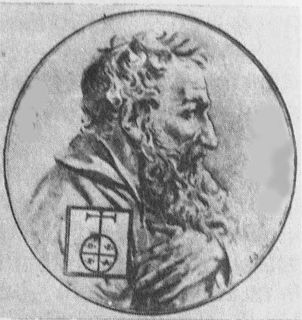
A manuscript was, traditionally, any document that is written by hand — or, once practical typewriters became available, typewritten — as opposed to being mechanically printed or reproduced in some indirect or automated way. More recently, the term has come to be understood to further include any written, typed, or word-processed copy of an author's work, as distinguished from its rendition as a printed version of the same. Before the arrival of printing, all documents and books were manuscripts. Manuscripts are not defined by their contents, which may combine writing with mathematical calculations, maps, explanatory figures or illustrations. Manuscripts may be in book form, scrolls or in codex format. Illuminated manuscripts are enriched with pictures, border decorations, elaborately embossed initial letters or full-page illustrations.
Year 1309 (MCCCIX) was a common year starting on Wednesday of the Julian calendar.

Harriet Elisabeth Beecher Stowe was an American abolitionist and author. She came from the Beecher family, a famous religious family, and is best known for her novel Uncle Tom's Cabin (1852), which depicts the harsh conditions for enslaved African Americans. The book reached millions as a novel and play, and became influential in the United States and Great Britain, energizing anti-slavery forces in the American North, while provoking widespread anger in the South. Stowe wrote 30 books, including novels, three travel memoirs, and collections of articles and letters. She was influential for both her writings and her public stances and debates on social issues of the day.

The Gospel Book, Evangelion, or Book of the Gospels is a codex or bound volume containing one or more of the four Gospels of the Christian New Testament – normally all four – centering on the life of Jesus of Nazareth and the roots of the Christian faith. The term is also used of the liturgical book, also called the Evangeliary, from which are read the portions of the Gospels used in the Mass and other services, arranged according to the order of the liturgical calendar.

The National Diet Library (NDL) is the national library of Japan and among the largest libraries in the world. It was established in 1948 for the purpose of assisting members of the National Diet of Japan in researching matters of public policy. The library is similar in purpose and scope to the United States Library of Congress.
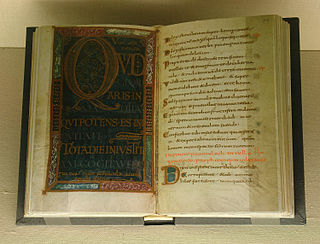
A psalter is a volume containing the Book of Psalms, often with other devotional material bound in as well, such as a liturgical calendar and litany of the Saints. Until the later medieval emergence of the book of hours, psalters were the books most widely owned by wealthy lay persons and were commonly used for learning to read. Many Psalters were richly illuminated and they include some of the most spectacular surviving examples of medieval book art.

The National Library of Sweden is the national library of Sweden. As such it collects and preserves all domestic printed and audio-visual materials in Swedish, as well as content with Swedish association published abroad. Being a research library, it also has major collections of literature in other languages.
Legal deposit is a legal requirement that a person or group submit copies of their publications to a repository, usually a library. The requirement is mostly limited to books and periodicals. The number of copies varies and can range from one to 19. Typically, the national library is one of the repositories of these copies. In some countries there is also a legal deposit requirement placed on the government, and it is required to send copies of documents to publicly accessible libraries.
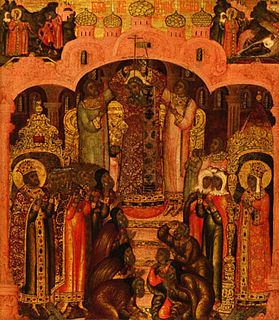
In the Christian liturgical calendar, there are several different Feasts of the Cross, all of which commemorate the cross used in the crucifixion of Jesus. While Good Friday is dedicated to the Passion of Christ and the Crucifixion, these days celebrate the cross itself, as the instrument of salvation. The most common day of commemoration is September 14 in Roman Catholicism and Eastern Orthodoxy.
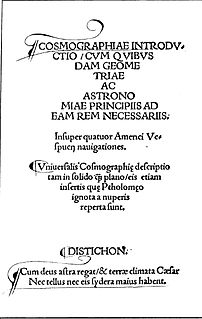
Cosmographiae Introductio was a book published in 1507 to accompany Martin Waldseemüller's printed globe and wall-map, which were the first appearance of the name 'America'. Waldseemüller’s maps and book, along with his 1513 edition of Ptolemy’s Geography, were very influential and widely copied at the time.

Google Books is a service from Google Inc. that searches the full text of books and magazines that Google has scanned, converted to text using optical character recognition (OCR), and stored in its digital database. Books are provided either by publishers and authors through the Google Books Partner Program, or by Google's library partners through the Library Project. Additionally, Google has partnered with a number of magazine publishers to digitize their archives.
The liturgical book called Octoechos contains a repertoire of hymns ordered in eight parts according to the eight echoi. Originally created as a hymn book with musical notation in the Stoudios monastery during the 9th century, it is still used in many rites of Eastern Christianity. The hymn book has something in common with the book tonary of the Western Church. Both contained the melodic models of the octoechos system, but the tonary served simply for a modal classification, while the book octoechos is as well organized as a certain temporal of several eight week periods and the word itself means the repertoire of hymns sung during the celebrations of the Sunday Office.

Armenian-Egyptian relations are foreign relations between Armenia and Egypt. Egypt was one of the first countries in the Arab world which recognized the independent Armenia in 1991. In March 1992, the diplomatic relations were established between the two countries. In May 1992, the first diplomatic mission of Armenia in the Arab East was inaugurated in Cairo. Egypt has an embassy in Yerevan.

A liturgical book, or service book, is a book published by the authority of a church body that contains the text and directions for the liturgy of its official religious services.

The British Library is the national library of the United Kingdom and the largest national library in the world by number of items catalogued. It is estimated to contain 150–200 million+ items from many countries. As a legal deposit library, the British Library receives copies of all books produced in the United Kingdom and Ireland, including a significant proportion of overseas titles distributed in the UK. The Library is a non-departmental public body sponsored by the Department for Culture, Media and Sport.
A digital library, digital repository, or digital collection, is an online database of digital objects that can include text, still images, audio, video, or other digital media formats. Objects can consist of digitized content like print or photographs, as well as originally produced digital content like word processor files or social media posts. In addition to storing content, digital libraries provide means for organizing, searching, and retrieving the content contained in the collection.
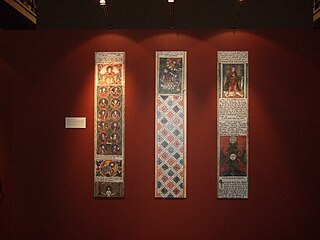
After the introduction of movable printing type to Europe by Johannes Gutenberg in Germany, Armenians from throughout the diaspora began to publish Armenian-language books. The first book which had Armenian letters was published in Mainz (Germany) in 1486. The first Armenian book to be published by the printing press was Urbatagirq—Book of Friday prayers—which was published by Hakob Meghapart in Venice in 1512.

